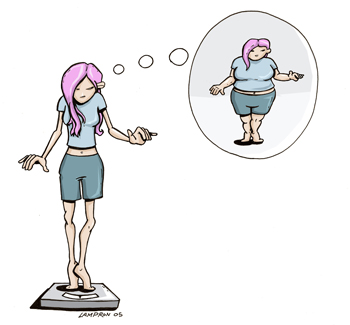One or two out of every one hundred students in America struggle with an eating disorder. Thousands of teenagers each year develop eating disorders, or problems with weight, eating, or body image. Anorexia nervosa and bulimia nervosa are two types of eating disorders with distinct clinical presentations. Anorexia involves reduced caloric intake that is brought about by self-induced starvation. People with this disorder have a fear of weight gain and a distorted view of their body shape and size. They are usually very thin and underweight. Bulimia also involves reduced caloric intake, but is brought about by binge eating and then gastrointestinal purging. People with this disorder may be a normal weight or can even be overweight, which makes it a little more difficult to detect. People suffering from bulimia secretly eat large amount of food, typically junk foods, at once until they are full. They then purge themselves by vomiting, or by using laxatives or excessive exercise.
People who develop these eating disorders may start off just wanting to lose some weight and get in shape; however, the urge to eat less, to purge, or to over-exercise gets addicting and becomes too difficult to stop. They often view themselves as being fat or have an intense fear of becoming fat. Some signs of anorexia are that the person becomes very thing, frail, or emaciated, he or she becomes obsessed with eating, food, and weight control, the person repeatedly weighs himself or herself, only eat certain foods, excessively exercise, feel fat, withdraw from social activities, become depressed, lethargic, and feel cold a lot, and count food portions carefully. Signs of bulimia include fear of weight gain, intense unhappiness with body size, shape, and weight, go to the bathroom immediately after meals, only eat diet or low-fat foods while not binging, regularly buy laxatives, diuretics, or enemas, spend most of his or her time exercising, and withdraw from social activities. A definite cause is not certain about eating disorders. Often times the onset of eating disorders may be caused by physical and emotional changes in teenagers, as well as academic pressures and peer pressure. Images of fit models or other famous individuals may also cause someone to believe they should look just like that person, thus creating an eating problem for the individual. Some sports can also create an atmosphere for the onset of eating disorders because athletes need to maintain a certain body weight in order to compete.
http://www.ncbi.nlm.nih.gov/pubmed/2181833
http://kidshealth.org/teen/food_fitness/problems/eat_disorder.html#


No comments:
Post a Comment